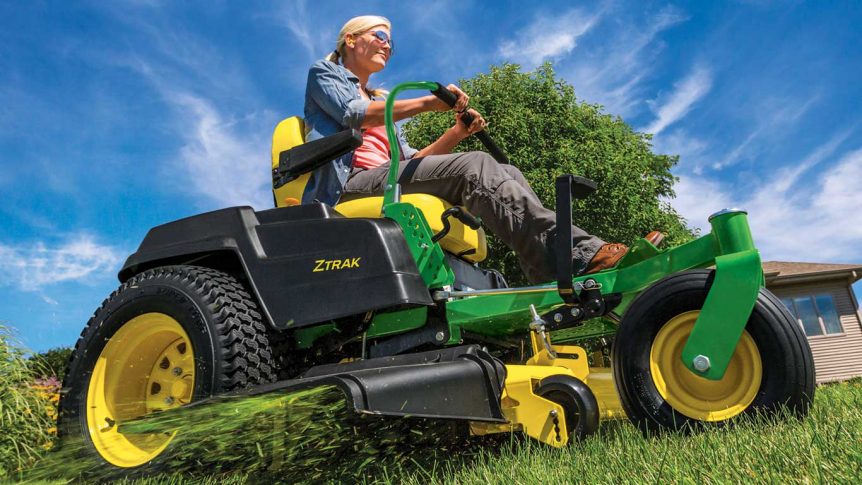The rev of a mower engine sparking to life in the neighborhood might as well be a track meet pistol. It signals a start. The start of summer, the weekend, or the day, it beckons lawn lovers outdoors to take in the sweet smell of fresh cut grass and get busy sprucing up their green spaces, too.
Done correctly, mowing offers more than just a cosmetic trim. It can control weeds, help recycle nutrients, encourage deep root growth, and contribute to the overall health and durability of the lawn. Best mowing practices will vary based on season, weather conditions, grass species, and how intensely a lawn is managed. Here are some points to consider when setting the course for your mowing path.
1. Make sure you have a sharp, properly installed mower blade.
As one would cringe at a dull razor, a lawn will similarly cower from the hacking treatment delivered by a dull blade. Even worse than a dull blade is one installed upside down causing the blunt backside of the blade to be the cutting edge. A dull blade won’t provide a clean cut, causing grass to look ragged. The resulting injury will also allow more entry points for insects and disease, says Laurie Trenholm, University of Florida urban turfgrass specialist. A clean cut from a sharp blade provides a nice, even look that is far healthier for the grass.
2. Determine your grass species.
There is no universal perfect mowing height for grass. Each species thrives at different heights based on their physiology.
“Ideal mowing height is based on the size of the grass species’ leaf blades. Finer bladed grasses can be mowed shorter while wide-leafed species do better with a little more height,” Trenholm says. St. Augustinegrass is at the top end of length for wide-leafed species, thriving at 3.5 to 4 inches tall while Centipedegrass, which grows prostrate to the ground, can be maintained at just 1 to 2 inches tall.
Fine-bladed cool season grasses, such as Kentucky bluegrass, should be kept around 2-inches tall, but can tolerate a mowing height of just 1 inch. Each grass species, and even some cultivars within a species, have a preferred height. Taking the time to identify the lawn’s grass species and search out the recommended cut height from the local county extension can help ensure a healthy, thriving lawn, Trenholm says.
3. Set the mower deck height.
The species of grass may be the first clue to where to set the mower, but it’s not the only consideration. The general rule of thumb when mowing is to try not to remove more than one third of the leaf tissue present in a single mowing.
“The lower you go, the more frequently you have to mow to maintain the desired height without taking off more than one third of the plant,” says Peter Landschoot, Penn State turfgrass specialist. He notes a shorter lawn also often has more weed problems because the canopy isn’t as thick. The open canopy allows more light to reach the soil and germinate weed seeds.
If lawns are continually allowed to grow too long and then cut back dramatically, it can stress grass. Stress will cause the grass to pull nutrients from the root system, degrading the roots and eventually resulting in a thinning, unhealthy lawn, says Clint Waltz, University of Georgia extension turfgrass specialist. Regularly cutting a lawn shorter than the grass species prefers will have the same effect.
“The best plan is to keep the mowing height consistent throughout the year. There’s no need to make a bunch of changes up and down, just leave the mower height set to where it’s ideal for the grass species growing,” Waltz says.
4. Mow at the right interval.
To maintain the desired height, mowing should occur when the grass needs a trim, not when the weekend falls. If a lawn is heavily fertilized and irrigated, or in its active growth period, it may need mowed twice a week. If grass has entered its dormant season or is suffering from drought stress, it may not need mowed at all. Again, it’s about following the rule of never removing more than one third of the leaf tissue at a time. If the desired lawn height is 2 inches, it needs to be cut when it grows to 3 inches tall.
“When a lawn is under drought stress, don’t mow at all,” Landschoot says. If grass is turning a bluish color indicating it’s very dry, even minor foot traffic can cause damage, he says, so hold off on mowing until conditions improve.
In early spring, the grass may not need cut, but the lawnmower may still be of use. Winter annual weeds that pop up before the grass starts actively growing can be somewhat controlled by mowing until the weather warms enough for herbicides to be more effective. This is also a useful practice for those with grass species, such as St. Augustinegrass, that may be harmed by an early herbicide application, says Waltz.
5. Plan for clippings.
In most cases, lawn clippings should be deposited right back onto the lawn. They’re full of nutrients the lawn can recycle and put to good use. “Generally, if you’re doing a good job of staying on top of mowing so there’s not big clumps of material left behind by the mower, there’s no need to remove clippings,” Waltz says. Even leaves, to a certain extent, can be mulched and left to feed the soil.
When grass has been left to grow too long and a lot of material will need to be dispersed or removed, or if dealing with a large amount of leaves in the fall, they should be removed to avoid smothering the lawn, Landschoot says.
Helpful links:

